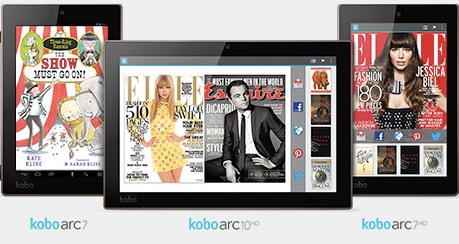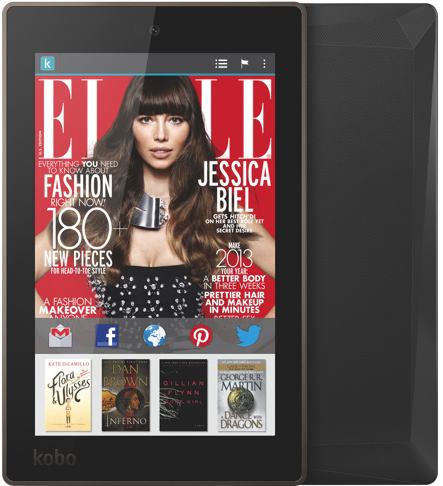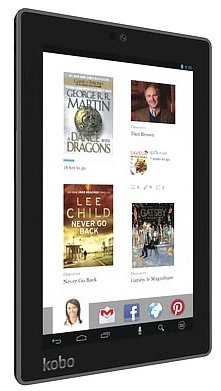
When it comes to e-readers and tablets, Kobo has grown from an underdog competing against the Kindle to a leading manufacturer that also happens to operate a top notch e-bookstore. The current line-up of Kobo Arc tablets is particularly attractive, offering performance, brilliant high resolution displays, full access to Android apps and combines this with Kobo’s e-book expertise. Kobo has positioned the Arc line as the best tablet choice for readers. But which Kobo Arc is the right choice for you? In this post, I explore the differences between the Kobo Arc 7HD, Kobo Arc 10HD and the Kobo Arc 7.
I am a big fan of Kobo products. They’ve come a long way since the first was released in 2010 and I now have 3 Kobo models among my e-reader collection —including my favourite, the Aura HD. I also own a Kobo tablet (a previous generation Arc), that serves as my primary Android tablet. And when it comes to loading up with reading material, Kobo operates an excellent e-bookstore, serving up a huge selection of digital books in ePUB format (none of that proprietary AZW nonsense).
In terms of the current Kobo arc lineup, here are the models being offered.
Product Specs:
|
Model |
Display Size |
Resolution |
Processor |
Memory/Storage |
Battery |
Size |
|
Kobo arc 7HD |
7-inch |
1920 x 1200 (323 ppi) |
Nvidia Tegra 3 quad-core at 1.7 GHz |
1GB RAM, 16/32GB storage |
4200 mAH up to 8 hours |
341g, 19.4 x 12.2 x 0.96 cm |
|
Kobo arc 10HD |
10.1-inch |
2560 x 1600 (300 ppi) |
Nvidia Tegra 4 quad-core at 1.8 GHz |
2GB RAM, 16GB storage |
6550 mAh hour up to 9.5 hours |
627g, 25.3 x 17.2 x 0.99 cm |
|
Kobo arc7 |
7-inch |
1024 x 600 (170 ppi) |
MKT quad-core at 1.2 GHz |
1 GB RAM, 8GB storage (expandable to 32GB with micro SD card) |
4200 mAh up to 9 hours |
360g, 19.4 x 12.2 x 1.0 cm |
Which Kobo Arc is the right one for you?
 Kobo Arc 10HD
Kobo Arc 10HD
I wrote a a few months ago, and its huge, bright and razor sharp display really stood out. If you’re looking for a full-sized Android tablet with the power to run the latest games, a display that’s ideal for multimedia use or for reading digital magazines, plus a reasonable price tag, then the Kobo Arc 10HD is your best choice. Despite the size, that 300ppi display means text remains crisp —something that not all full-sized tablets can pull off— so you’re not giving up on the reading experience.
 Kobo Arc 7HD
Kobo Arc 7HD
Sporting a sharp 323 ppi display, the Kobo Arc 7HD makes an ideal e-reader for someone who wants to be able to slip a tablet into their pocket. Available in a 16GB version or a 32 GB version, it’s also well suited for a user who wants to carry around a huge e-book library and load up with apps, videos or music.
 Kobo Arc 7
Kobo Arc 7
Just because you’re on a budgets doesn’t mean a Kobo Arc tablet is out of reach. The Kobo Arc 7 may not be as powerful or sport the high resolution displays the HD models do and it lacks a camera, but it’s still a solid performer with a good looking display. It runs Android, lets you download apps, read e-books and watch video. In fact, this model has one advantage over the HD versions —a microSD slot so you can inexpensively expand your storage at will. Although it gives up a few features, the Kobo Arc 7 doesn’t look or feel like an entry level tablet.
All three of these Kobo Arc tablets run Android and are certified to download apps from Google’s app store and come preloaded with common apps like YouTube, Facebook and Google Maps. In other words, they’re fully functional Android tablets. All three also benefit from Kobo’s long history of improving the e-reading experience on all their devices —from extensive TypeGenius font fine-tuning to a distraction-free Reading Mode and the Kobo Reading Life enriched reading, organization and sharing software.
In other words, whichever Kobo Arc you choose, you can be sure the tablet won’t just let you play games or watch movies, it will more than meet your reading needs.



